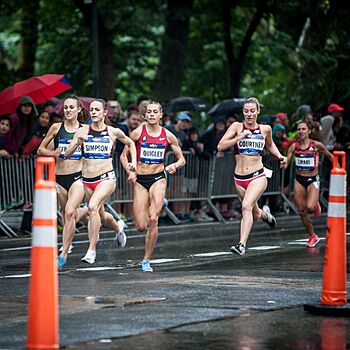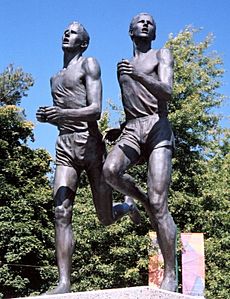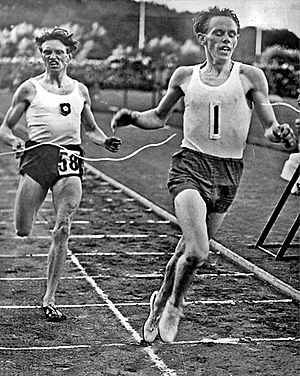Mile run facts for kids
Quick facts for kids AthleticsMile run |
|
|---|---|

Matt Centrowitz and Nick Willis racing for first place in the 2015 Wanamaker Mile. Centrowitz ends up beating Willis by 0.11 seconds, in a time of 3:51.35.
|
|
| World records | |
| Men | |
| Women | |
| Short track world records | |
| Men | |
| Women | |
| World junior (U20) records | |
| Men | |
| Women | |
The mile run is a famous foot race in athletics. It covers a distance of 1,760 yards, which is 5,280 feet, or exactly 1,609.344 metres. This makes it a middle-distance event.
Even though many races now use the metric distances, like the 1500 metres, the mile run is still very popular. It's the only imperial distance that has official world records recognized by World Athletics, the main group for track and field sports.
Some of the most exciting mile races happen every year. These include the Wanamaker Mile, Dream Mile, Emsley Carr Mile, and Bowerman Mile.
| Athletics Road Mile |
|
|---|---|

2018 Women's Fifth Avenue Mile.
|
|
| World records | |
| Men | |
| Women | |
The current world record for men is held by Hicham El Guerrouj from Morocco. He ran the mile in an amazing 3 minutes, 43.13 seconds. For women, the record is held by Faith Kipyegon from Kenya, with a time of 4 minutes, 7.64 seconds.
The mile run is a bit longer than the 1500 metres race. Even though it's only about 109 metres more, many runners find it much harder. Hicham El Guerrouj, the world record holder, said the mile needs a lot of physical and mental strength.
Contents
History of the Mile Run
The mile run started in England a long time ago. In 1593, the English Parliament officially set the distance of a mile to 1,760 yards. Back then, people would bet on races, and the mile was a popular distance for these gambling contests. Many people would come to watch and bet, and some runners even became professionals.
In the late 1800s, running became more popular. There were separate records for amateur (non-professional) and professional runners. Professional runners often had faster times. Famous races between runners like William Cummings and Walter George in Britain, and George against American Lon Myers, made the sport very exciting.
Before countries started using the metric system, many running tracks were built to be exactly a quarter of a mile long (440 yards). This meant that a mile race was exactly four laps around the track. Countries like the United States and those in the Commonwealth of Nations switched to metric rules in the mid-1900s. However, the mile race remained popular.

The International Amateur Athletics Federation (now called World Athletics) was formed in 1912. They officially recognized the first world record for the mile in 1913. It was set by John Paul Jones with a time of 4 minutes, 14.4 seconds.
The mile run kept its official world record status even after 1976, when most other imperial distances were no longer officially recognized. This shows how important and popular the mile race still is around the world.
Many great runners in the early 1900s set world records in the mile, including Paavo Nurmi, Jack Lovelock, and Sydney Wooderson. In the 1940s, Swedish runners Gunder Hägg and Arne Andersson had a big rivalry. They each set three world records during that time.
The Four-Minute Mile
A huge goal for runners in the 1950s was to run the mile in under four minutes. This challenge made the mile race even more famous. On May 6, 1954, an English runner named Roger Bannister became the first person to achieve this amazing feat. He ran the mile in 3 minutes, 59.4 seconds. He had help from other runners, Chris Brasher and Chris Chataway, who helped set the pace. This event was a big moment for using "pacemakers" in races, which is now common in many top-level races.
In the 1960s, American runner Jim Ryun set world records close to 3 minutes, 50 seconds. He was also the first high school student to run a mile in under four minutes. His training methods are still used by many runners today. Around this time, African runners started to become very strong in middle-distance races. Kip Keino from Kenya won the mile at the 1966 British Empire and Commonwealth Games.
In 1975, Filbert Bayi from Tanzania became the first African to hold the mile world record. A few months later, John Walker from New Zealand broke Bayi's record, becoming the first man to run under 3 minutes, 50 seconds. The 1980s were famous for the rivalry between British runners Sebastian Coe and Steve Ovett. They broke the mile record five times between them.
Later, Noureddine Morceli from Algeria brought the record back to Africa in 1993. The current men's world record was set by Hicham El Guerrouj from Morocco in 1999, with a time of 3 minutes, 43.13 seconds. Since then, the fastest mile run by a man was Jakob Ingebrigtsen's 3:43.73 in 2023.
Mile races are still a big part of many track and field events today, from high school meets to professional competitions. In the United States, the 1600 metres race is often run instead of the mile in high school.
Besides track races, mile runs also happen on roads, like the famous Fifth Avenue Mile in New York City.
In 2019, World Athletics President Sebastian Coe held a special event in Monaco to celebrate the mile. Many past world record holders attended, including Ron Delany, Jim Ryun, Filbert Bayi, and Hicham El Guerrouj. The event also honored Roger Bannister and Diane Leather Charles, who were the first man and woman to break the four-minute and five-minute mile barriers.
It was announced in February 2025 that the mile run will return to the 2026 Commonwealth Games, replacing the 1500 metres.
Mile Records
The mile run has different records depending on where the race is held: outdoors on a track, indoors on a track, or on a road.
Outdoor Records
These are the fastest times run on outdoor tracks.
| Area | Men's | Women's | ||
|---|---|---|---|---|
| Time | Athlete | Time | Athlete | |
| World | 3:43.13 | 4:07.64 | ||
| Continental records | ||||
| Africa | 3:43.13 | 4:07.64 | ||
| Asia | 3:47.97 | 4:17.75 | ||
| Europe | 3:43.73 | 4:12.33 | ||
| North, Central America and Caribbean |
3:43.97 | 4:16.35 | ||
| Oceania | 3:47.48 | 4:15.34 | ||
| South America | 3:51.05 | 4:30.05 | ||
Indoor Records
These are the fastest times run on indoor tracks.
| Area | Men's | Women's | ||
|---|---|---|---|---|
| Time | Athlete | Time | Athlete | |
| World | 3:45.14 | 4:13.31 | ||
| Continental records | ||||
| Africa | 3:47.01 | 4:13.31 | ||
| Asia | 3:57.05 | 4:24.71 | ||
| Europe | 3:45.14 | 4:17.14 | ||
| North, Central America and Caribbean |
3:46.63 | 4:16.85 | ||
| Oceania | 3:47.48 | 4:19.03 | ||
| South America | 3:56.26 | 4:42.24 | ||
Road Records
These are the fastest times run on roads. World Athletics has special rules for road records, like how steep the course can be. The road mile became an official world record event on September 1, 2023.
| Area | Men's | Women's | ||
|---|---|---|---|---|
| Time | Athlete | Time | Athlete | |
| World | 3:51.3h | 4:20.98 | ||
| Continental records | ||||
| Africa | 3:52.45 | 4:20.98 | ||
| Asia | 4:01.26 | 4:29.79 | ||
| Europe | 3:51.3h | 4:29.0h | ||
| North, Central America and Caribbean |
3:51.9h | 4:25.0h | ||
| Oceania | 3:56.57 | 4:32.0h | ||
| South America | 4:02.75 | none | none | |
More About the Mile Run



